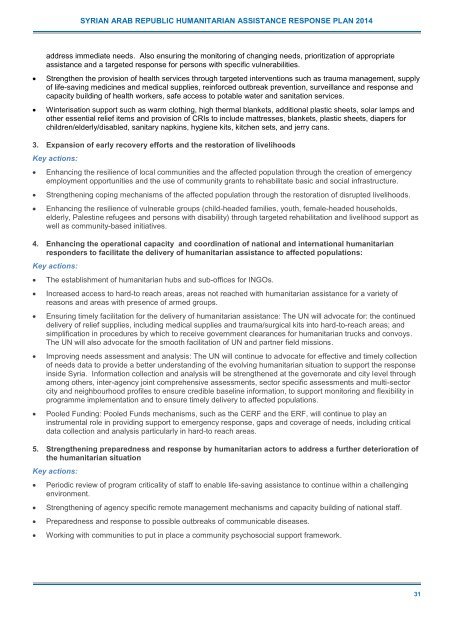2014 Syrian Arab Republic Humanitarian Assistance Response Plan (SHARP)
- No tags were found...
Create successful ePaper yourself
Turn your PDF publications into a flip-book with our unique Google optimized e-Paper software.
SYRIAN ARAB REPUBLIC HUMANITARIAN ASSISTANCE RESPONSE PLAN <strong>2014</strong><br />
<br />
<br />
address immediate needs. Also ensuring the monitoring of changing needs, prioritization of appropriate<br />
assistance and a targeted response for persons with specific vulnerabilities.<br />
Strengthen the provision of health services through targeted interventions such as trauma management, supply<br />
of life-saving medicines and medical supplies, reinforced outbreak prevention, surveillance and response and<br />
capacity building of health workers, safe access to potable water and sanitation services.<br />
Winterisation support such as warm clothing, high thermal blankets, additional plastic sheets, solar lamps and<br />
other essential relief items and provision of CRIs to include mattresses, blankets, plastic sheets, diapers for<br />
children/elderly/disabled, sanitary napkins, hygiene kits, kitchen sets, and jerry cans.<br />
3. Expansion of early recovery efforts and the restoration of livelihoods<br />
Key actions:<br />
<br />
<br />
<br />
Enhancing the resilience of local communities and the affected population through the creation of emergency<br />
employment opportunities and the use of community grants to rehabilitate basic and social infrastructure.<br />
Strengthening coping mechanisms of the affected population through the restoration of disrupted livelihoods.<br />
Enhancing the resilience of vulnerable groups (child-headed families, youth, female-headed households,<br />
elderly, Palestine refugees and persons with disability) through targeted rehabilitation and livelihood support as<br />
well as community-based initiatives.<br />
4. Enhancing the operational capacity and coordination of national and international humanitarian<br />
responders to facilitate the delivery of humanitarian assistance to affected populations:<br />
Key actions:<br />
<br />
<br />
<br />
<br />
<br />
The establishment of humanitarian hubs and sub-offices for INGOs.<br />
Increased access to hard-to reach areas, areas not reached with humanitarian assistance for a variety of<br />
reasons and areas with presence of armed groups.<br />
Ensuring timely facilitation for the delivery of humanitarian assistance: The UN will advocate for: the continued<br />
delivery of relief supplies, including medical supplies and trauma/surgical kits into hard-to-reach areas; and<br />
simplification in procedures by which to receive government clearances for humanitarian trucks and convoys.<br />
The UN will also advocate for the smooth facilitation of UN and partner field missions.<br />
Improving needs assessment and analysis: The UN will continue to advocate for effective and timely collection<br />
of needs data to provide a better understanding of the evolving humanitarian situation to support the response<br />
inside Syria. Information collection and analysis will be strengthened at the governorate and city level through<br />
among others, inter-agency joint comprehensive assessments, sector specific assessments and multi-sector<br />
city and neighbourhood profiles to ensure credible baseline information, to support monitoring and flexibility in<br />
programme implementation and to ensure timely delivery to affected populations.<br />
Pooled Funding: Pooled Funds mechanisms, such as the CERF and the ERF, will continue to play an<br />
instrumental role in providing support to emergency response, gaps and coverage of needs, including critical<br />
data collection and analysis particularly in hard-to reach areas.<br />
5. Strengthening preparedness and response by humanitarian actors to address a further deterioration of<br />
the humanitarian situation<br />
Key actions:<br />
<br />
<br />
<br />
<br />
Periodic review of program criticality of staff to enable life-saving assistance to continue within a challenging<br />
environment.<br />
Strengthening of agency specific remote management mechanisms and capacity building of national staff.<br />
Preparedness and response to possible outbreaks of communicable diseases.<br />
Working with communities to put in place a community psychosocial support framework.<br />
31



